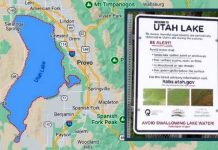UTAH, June 7, 2020 (Gephardt Daily) — As warmer weather returns to Utah, residents are advised to take steps to protect themselves from harmful algal blooms and waterborne pathogens while recreating on the water.
Utah’s Department of Environmental Quality, Division of Water Quality and the Department of Natural Resources issued the warning by way of a news release.
“There are a number of factors that contribute to the development of harmful algal blooms,” Division of Water Quality Director Erica Gaddis. “These include weather patterns, temperature and nutrients; nitrogen and phosphorus, in the water. Before boating, swimming or fishing, be sure to check water conditions.”
Harmful algal blooms occur when stagnant, nutrient-rich water warms up in the summer and becomes the ideal breeding ground for cyanobacteria — commonly known as blue-green algae. Under these circumstances, the bacteria can reproduce quickly, overwhelm the waterbody and in some cases produce skin, liver and nervous system toxins.
Harmful algal blooms may look like pea soup, green or blue paint, or have a scum layer or mats/foam floating on the surface. The water may also appear in shades of green, blue-green, yellow, brown or red.
Waterborne pathogens are bacteria, viruses and parasites that can occasionally be found in Utah waters, the news release said. These waterborne pathogens can cause diarrhea, vomiting, cramps, fever and rashes. People can be exposed to these pathogens if they swallow water when they swim or eat food without washing their hands first.
The Division of Water Quality and local health departments usually sample waterbodies for waterborne pathogens throughout the recreation season, May to October, to keep the public, local health departments and other stakeholders informed of current conditions. DWQ posts updates on sampling results and health advisories as soon as the information becomes available at ecoli.utah.gov.
Due to state budget uncertainty, DWQ cannot monitor, sample or provide updates for harmful algal blooms on Utah waterbodies until at least July 1 this year.
Because cyanobacteria blooms can appear quickly — sometimes in hours — and shift locations based on weather conditions, water recreators are asked to avoid:
- Water that resembles spilled paint, antifreeze or grass clippings
- Surface scum or film
- Discolored or streaking water
- Green globs on or below the surface of the water
Water recreators can take a few simple steps to protect themselves, their families and their pets while enjoying Utah’s waters:
- Don’t swallow water when swimming
- Avoid areas of scum when boating
- Wash hands with clean water before eating or preparing food
- When fishing, clean fish well and discard the guts
- Don’t let pets drink from scummy water
For concerns about possible human exposure, call your physician or Utah Poison Control at 800-222-1222. For concerns about possible animal exposure, contact a local veterinarian. For concerns about possible livestock exposure, contact the Utah Department of Agriculture and Food at 801-538-7100.
To learn more about harmful algal blooms, visit habs.utah.gov.







